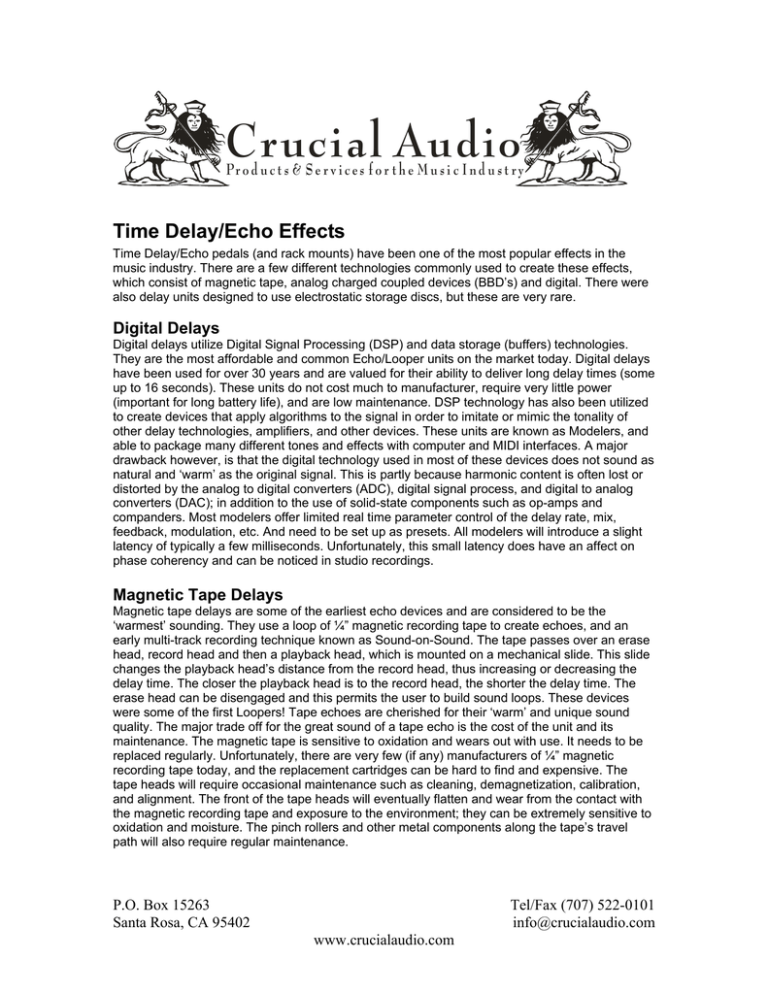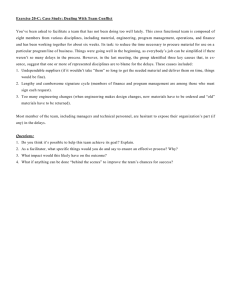Time Delay/Echo Effects
advertisement

Crucial Audio Pr o d u c t s & S e r v i c e s f o r t h e M u s i c I n d u s t r y Time Delay/Echo Effects Time Delay/Echo pedals (and rack mounts) have been one of the most popular effects in the music industry. There are a few different technologies commonly used to create these effects, which consist of magnetic tape, analog charged coupled devices (BBD’s) and digital. There were also delay units designed to use electrostatic storage discs, but these are very rare. Digital Delays Digital delays utilize Digital Signal Processing (DSP) and data storage (buffers) technologies. They are the most affordable and common Echo/Looper units on the market today. Digital delays have been used for over 30 years and are valued for their ability to deliver long delay times (some up to 16 seconds). These units do not cost much to manufacturer, require very little power (important for long battery life), and are low maintenance. DSP technology has also been utilized to create devices that apply algorithms to the signal in order to imitate or mimic the tonality of other delay technologies, amplifiers, and other devices. These units are known as Modelers, and able to package many different tones and effects with computer and MIDI interfaces. A major drawback however, is that the digital technology used in most of these devices does not sound as natural and ‘warm’ as the original signal. This is partly because harmonic content is often lost or distorted by the analog to digital converters (ADC), digital signal process, and digital to analog converters (DAC); in addition to the use of solid-state components such as op-amps and companders. Most modelers offer limited real time parameter control of the delay rate, mix, feedback, modulation, etc. And need to be set up as presets. All modelers will introduce a slight latency of typically a few milliseconds. Unfortunately, this small latency does have an affect on phase coherency and can be noticed in studio recordings. Magnetic Tape Delays Magnetic tape delays are some of the earliest echo devices and are considered to be the ‘warmest’ sounding. They use a loop of ¼” magnetic recording tape to create echoes, and an early multi-track recording technique known as Sound-on-Sound. The tape passes over an erase head, record head and then a playback head, which is mounted on a mechanical slide. This slide changes the playback head’s distance from the record head, thus increasing or decreasing the delay time. The closer the playback head is to the record head, the shorter the delay time. The erase head can be disengaged and this permits the user to build sound loops. These devices were some of the first Loopers! Tape echoes are cherished for their ‘warm’ and unique sound quality. The major trade off for the great sound of a tape echo is the cost of the unit and its maintenance. The magnetic tape is sensitive to oxidation and wears out with use. It needs to be replaced regularly. Unfortunately, there are very few (if any) manufacturers of ¼” magnetic recording tape today, and the replacement cartridges can be hard to find and expensive. The tape heads will require occasional maintenance such as cleaning, demagnetization, calibration, and alignment. The front of the tape heads will eventually flatten and wear from the contact with the magnetic recording tape and exposure to the environment; they can be extremely sensitive to oxidation and moisture. The pinch rollers and other metal components along the tape’s travel path will also require regular maintenance. P.O. Box 15263 Santa Rosa, CA 95402 Tel/Fax (707) 522-0101 info@crucialaudio.com www.crucialaudio.com Analog Delays Analog Delays used charged coupled devices known as Bucket Brigades (BBD). BBD’s consists of a series of field effect transistors (FET) and capacitors that pass the input signal to the device’s output at a time that is in accordance to the clock rate (delay time control). These devices typically have low signal loss (< .3dBc) and can be arranged in series to create longer echoes. These devices are revered for their warm and seeming tape-like quality of tone. One unique characteristic of analog delay feed back, is that the sound quality of the echo changes with each repeat; unlike that of most digital delays with identical sounding repeats. This characteristic of analog delays also occurs in nature, similar to the quality of the sonic reflections in a large canyon or off of other structures. Traditional analog delays also offer real-time parameter control, and the infinite feedback setting can be used in conjunction with the delay time changes to create modulated and repeated (wild swirly-like) sounds. Analog delays also have their issues. BBD’s are typically noisy at lower clock rates, and require signal conditioning circuits (such as Companders) to improve the signal to noise ratio; and Low Pass Filters (~10kHz) to attenuate the clock frequency from the audio signal. The companders and clock filters, along with the solidstate preamp circuitry, found in many lower-end analog delays tend to squash the dynamics and high frequency response of the delayed signal. Additionally, most BBD’s are now out of production and many companies are utilizing old stock or are no longer in production. In summary, all of these technologies have their benefits and compromises. Musicians and engineers should consider pairing their choice of delay with their sonic objective as well as budget. It is not uncommon to use multiple types of delays for various textures and tones. For example, a digital delay will deliver long delays and are great for loops. Analog delays are best suited for shorter delay times, slap backs, doubling, reverbs, and ear spinning feedback/time effects. Tape echoes are great all around units when they are properly maintained. Why purchase a Crucial Audio® Vacuum Tube Analog Delay? We took all the best technology we could find and added the organic warmth of vacuum tubes to create a product that represents what we consider to be the best in tonal landscaping. Crucial Audio has combined the unique (tape-like) sound quality, and real-time parameter control benefits of an Analog Delay with the warm and brilliant sound fidelity from a high voltage/low noise vacuum tube interface circuit. The Vacuum Tube Analog Delay is a lower maintenance and sturdier alternative to the magnetic tape echoes, and offers a warmer tone than the digital delays and modelers. The Echo-Nugget™ offers switch-able output level with a tone control, and the Time Warp™ offers switch-able modulation with depth and rate controls. The dual layer FR4 PC Boards are manufactured in the USA, by a UL approved facility. The anodized extruded aluminum chassis is custom designed by Crucial Audio and also manufactured in the USA. The delays come stock with two 12AX7A vacuum tubes, and can accept a wide variety of 9-pin twin triodes (please refer to the tube chart in the product manual). No Op-Amps are used in the audio signal path, and the signal maintains its warm and natural qualities. For more information, sound bytes, and news, please, visit us at www.crucialaudio.com. P.O. Box 15263 Santa Rosa, CA 95402 Tel/Fax (707) 522-0101 info@crucialaudio.com www.crucialaudio.com


